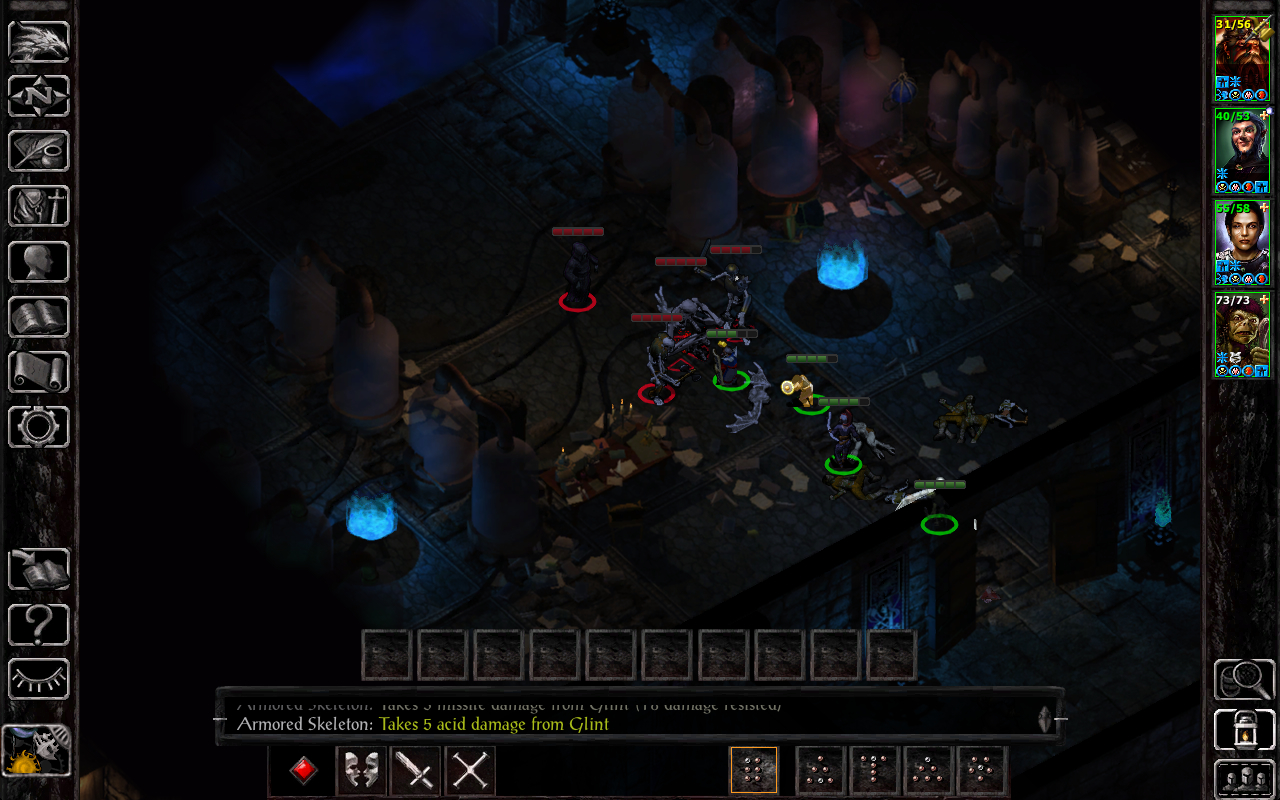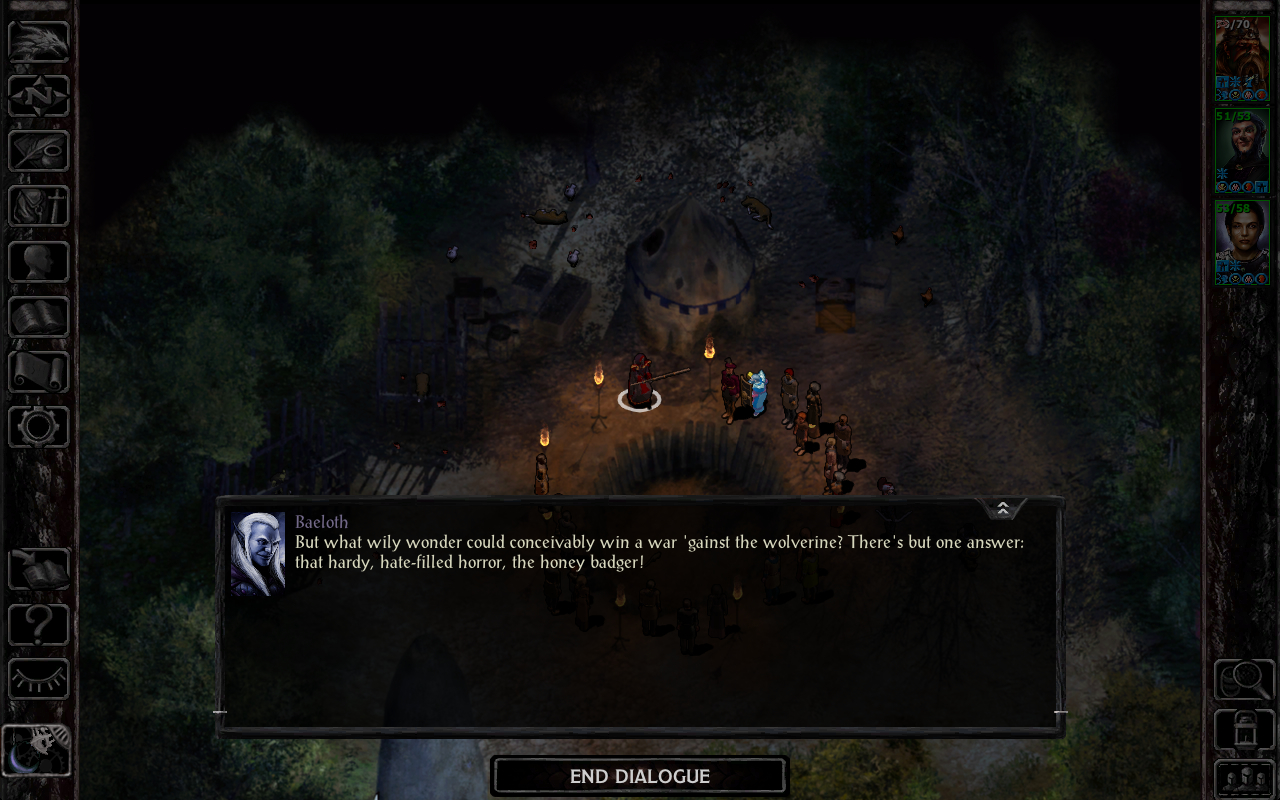Search
[{{{type}}}] {{{reason}}}
{{/data.error.root_cause}}{{{_source.title}}} {{#_source.showPrice}} {{{_source.displayPrice}}} {{/_source.showPrice}}
{{#_source.showLink}} {{/_source.showLink}} {{#_source.showDate}}{{{_source.displayDate}}}
{{/_source.showDate}}{{{_source.description}}}
{{#_source.additionalInfo}}{{#_source.additionalFields}} {{#title}} {{{label}}}: {{{title}}} {{/title}} {{/_source.additionalFields}}
{{/_source.additionalInfo}}- Details
- Category: Computer
- By J. Todd Cumming
- Hits: 7212
Baldur's Gate: Siege of Dragonspear (Mac)

Baldur's Gate: Siege of Dragonspear
Developed by: Beamdog Studios
Published by: Beamdog Studios
Released: March 31, 2016
Available on: Windows, Mac OS X
Genre: Role-playing
ESRB rating: T (animated blood, mild language, use of alcohol and tobacco)
Number of players: 1
Price: $19.99 (requires Baldur's Gate: Enhanced Edition to play)
Thank you, Beamdog Studios, for sending us a copy of the expansion for review!
The Baldur's Gate games, which were initially released in 1998, received a revamped, "enhanced edition" upgrade in 2013. The new edition was met with high praise, especially from those who remembered the original and were delighted to be able to play it on modern systems. Recently, Beamdog released the first new expansion for the franchise in 15 years. Titled "Siege of Dragonspear," the game plays exactly like the other games, and serves to tell the story between the two games. But is it worth the hype?
In some ways, yes. The game does have a lot of the feel and experience of the original game. You can import your character from the original, or create a new one solely to play the expansion. The gameplay is the same as well. Roughly based on the 2nd Edition Advanced Dungeons and Dragons rules, you make your character and assign points to flesh out your basic stats (Strength, Dexterity, Intelligence, and so forth). You choose a race and a class, and make other choices based on those. The expansion launches you into the game on the assumption that you've played the base game already, so there's no in-game tutorial at this point to help you. (If you haven't played Baldur's Gate yet, you may want to do that first so you'll know how to play the expansion.)
The game is presented as an isomorphic, top-down field, where you move your character through tunnels and wilderness, battle fiendish monsters, get experience and treasure, and all the other tropes that you can expect to find in a role-playing game. Then again, this is Dungeons and Dragons we're talking about – this is the franchise that made most of those tropes in the first place.
Unfortunately, the player is forced into a railroad plot and not allowed much in the way of variation. The game is supposed to "connect the dots" between the first and second games, but some degree of player choice would have been nice in affecting the outcome. There are several side quests which the player can engage in – some of which are quite amusing – but that's about it. At least you can add some experience and levels to your Baldur's Gate character before importing it into Baldur's Gate II, right?

Strong Points: Adds to the base game; entertaining characters and side quests
Weak Points: Fails to adhere to established lore; confusing battle system; railroad main plot
Moral Warnings: Blood, gore, murder, undead and magic use are all prominent; one transgender character makes a minor appearance.
My biggest criticism of the game is that it lacks the feel of a table-top experience. Everything happens in real-time, and while you can pause the game to issue orders to your characters, combat generally acts out more like a quick time event than a player-controlled battle. Especially at the lower difficulty levels – where victory is guaranteed – combat seems like a pointless addition to the game. It's like Diablo-lite, where the computer controls your character for you so you don't have to do all the thinking. Of course, this is a criticism I had of the original game back in 1998, too. Maybe it's because I grew up with the "Gold Box" series of Dungeons and Dragons games, where combat was turn-based – it's what I'm familiar with, and what I expect from a game sporting the D&D label. Your mileage may vary in this regard. And combat is heavily featured in this expansion – while it's possible to talk your way out of some conflicts, a good portion of the dialogue trees will end up in a battle no matter what you choose.
On top of that, the AI of the characters seems distinctly lacking. There were many times that my party was under fire, and Corwin – who is supposed to be an archer specialized in the longbow – would just stand in one place watching what was going on. Even after ordering her to attack, she'd fire one arrow and continue to watch as the rest of the team got peppered with projectiles. Fortunately, the AI of the computer seems to be just as deficient, with the standard "zerg-rush" approach being the default. It would be easy to lure the enemy into a variety of traps, if only the player-controlled characters were intelligent enough to follow orders. It's possible that this was simply the result of the difficulty level I was playing – "story mode," the easiest setting, so I could explore the plot. In this mode, the characters can't be killed and have received significant buffs in order to blaze through combat. The enemies might show a bit more intelligence at higher difficulties, but somehow I doubt it.
The voice-acting tends to be a mixed bag – some of the new characters and voices are delightful, and in other places the acting seems stiff or tired. The music is still phenomenal, though. The graphics are identical to those in the base game (although I would have preferred less dwarf-like sprite for Glint, the gnome cleric/thief).

Higher is better
(10/10 is perfect)
Game Score - 68%
Gameplay - 10/20
Graphics - 7/10
Sound - 7/10
Stability - 5/5
Controls - 5/5
Morality Score - 56%
Violence - 3/10
Language - 6.5/10
Sexual Content - 6/10
Occult/Supernatural - 4/10
Cultural/Moral/Ethical - 8.5/10
For fans of the franchise – or the Forgotten Realms itself – some of the plot elements may leave them scratching their heads. I was the DM for a campaign set along the Sword Coast for many years, so I know the region quite intimately. Early on, while playing this expansion, it is revealed that thousands of refugees have flooded Baldur's Gate, driven from their homes by Caelen Argent's crusade. My first thought was "fled from where?" Double-checking my map confirmed my suspicions – there are no settlements between Waterdeep and Baldur's Gate. Most of the people living in this region are rugged individualists, who would either die defending their land, or stubbornly rebuild elsewhere. While a few may flee to Baldur's Gate for shelter (Or Scornubel to the east, or Waterdeep to the north), it wouldn't be to such an extent where the city's resources and supplies are strained. This is not the only odd element I've run across in the expansion, and I can't help but wonder how much research the writers did in developing the storyline. Forgotten Realms fans will likely be disappointed with the "artistic licenses" this game takes.
When the game was released, there was a "controversial" element in the game, in the apparent inclusion of a "trans-gender" character. I didn't find the character – a cleric of Tempus named Mizhena – until after I consulted a walkthrough to find where she was located (in the camp of one of the early areas, in case you were wondering). Mizhena looks like any other Flaming Fist mercenary, and doesn't even have her own portrait, so it's easy to overlook her. For some reason, her inclusion set off a lot of people, who proceeded to give the game a "0" score in their own reviews of the game, and prompted Beamdog into editing the game through a patch. In my opinion, the response is overblown. Mizhena has no quests, no relevance to the plot, and isn't even a storekeeper. She feels like the "token minority" that was thrown in so Beamdog could point and say "see? Diversity!" If it wasn't for the fact that the Internet seemed to erupt over Mizhena's inclusion in the game, I likely wouldn't have even mentioned her in this review.
Aside from the transgender issue, there are several other moral considerations to the game. These are all elements of the original Baldur's Gate, so there's nothing new in this list. Swearing is commonplace throughout, although none of the more egregious vulgarities are used. The undead are commonplace enemies. The entire setting is polytheistic, and some of the characters are the result of a union between gods (or other divine beings) and mortals. Some enemies explode into chunks when killed – it's possible to turn off gore in the options menu, though. What can't be turned off are the rivers and pools of blood in some areas, or an eventual visit to a hellish landscape and battles against demons. The player can choose to be evil, if they'd like, and fill their party with evil characters. Finally, the players can control characters who can cast divine or arcane spells, and magic use is prominent.
So, all in all, the Siege of Dragonspear expansion is an interesting mix. What Baldur's Gate does well, Dragonspear does just as well. Where Baldur's Gate falters, the expansion seems to steer into sheer ineptitude. The new characters and side quests are entertaining, but those who were looking for a seamless transition between Baldur's Gate and Baldur's Gate II will be sorely disappointed – especially if they are fans of the Forgotten Realms. While it may be an interesting experience, I certainly wouldn't pay $19.99 for it, and I don't think it's even worth picking up on sale. Diehard fans of the Baldur's Gate series are better off using their imaginations to connect the two games. It's a disappointing chapter to an otherwise excellent story.








